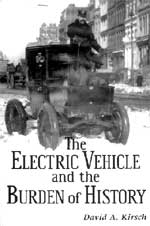Distant dream
 stories of how a promising technology can lose out in the maddening race for survival or the top slot always make interesting reading. This book is another such instance. But much more than that it is a critique on social choice, triumph of one technology over its competitors, some landmark decisions and the folly of projecting the future.
stories of how a promising technology can lose out in the maddening race for survival or the top slot always make interesting reading. This book is another such instance. But much more than that it is a critique on social choice, triumph of one technology over its competitors, some landmark decisions and the folly of projecting the future.
"At that busy corner, Grand Street and the Bowery, there may be seen cars propelled by five different methods of propulsion by steam, by cable, by underground trolley, by storage battery and by horses,' reported the news daily New York Sun in 1898. That was the mood in the late 1980s and early twentieth century when various automobile technologies were jostling for their share of the market. For some years the electric vehicle industry outlook was upbeat with a definite edge over its steam and gasoline counterparts. But in the next two decades it became clear that electric vehicles were falling back in the race with those run on internal combustion engine.
Making inroads into the history of the electric vehicle, the book narrates the saga of the rise and fall of these fascinating modes of transport. It is divided into three partsthe first setting the tone for the analysis and narration in the proper context. Part two presents the unfolding of events during the first decade of the last century when the electric vehicle got off to a promising start but soon began floundering in the midst of the emerging difficulties. The concluding part concentrates on three different perspectives connecting the historical episodes of the second section with more recent automotive history.
The author is critical of the historical approach that focuses on the vehicle alone and, therefore, makes a conscious attempt to delve into the issue of placing the choice of one particular technology into a wider perspective of transportation system. The story starts with the inauguration of the electric cab and carriage service in New York City in March 1897. It continues with the establishment of the Electric Vehicle Company and its progress thereafter. The author then moves on to take up the crucial issue of organisational support for electric vehicles which was initiated only in 1909. According to Kirsch, the latter development came too late. "Had the industry been able to organise itself in support of electric vehicles by 1900 instead of 1910, the urban service market might have become self-sustaining regardless of the ultimate fate of the private electric passenger vehicle,' he opines.
The history of the electric truck perhaps best exemplifies the demise of the notion that different forms of transportation technology might coexist, each in its own distinct sphere of service. Electric trucks maintained a significant share of the commercial market well into the second decade of the century. Early adopters of all types of motor vehicles suffered from problems with reliability and unpredictable operating costs and were wary of unknown technology, and change was incremental. They experimented. But small-scale operators could not afford the multiple vehicles needed to take advantage of functional specialisation. Seeking a single, universal truck, local merchants had little alternative but to choose internal combustion engines. The end of separate spheres ultimately signalled the end of the electric truck.
Roads with a special emphasis on access to fuel and charging facilities set the boundaries within which technological choices had to be made. The author recounts the interesting tale of how touring, the preferred activity of early motorists, was difficult in an electric vehicle. Yet many accepted the challenge and met with varying degrees of success. Still, lack of direction and inability on the part of the manufacturers, battery makers and light and power companies to decide on how best to position the electric vehicle to enable the industry to survive and grow, only spelt doom for the technology. All this while internal combustion engine kept consolidating its hold on the automobile market, further raising the bar for a successful electric passenger vehicle.
The author raises the big question of whether the electric vehicles can ever hope to escape the burden of history the burden of failure. His definitive
